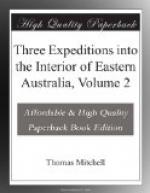Graves of the natives.
Choose a position for the depot.
My horse killed by the kick of a mare.
Proceed to the Darling with a portion of the party.
Reach the Murray.
Its breadth at our camp.
Meet with a tribe.
Lake Benanee.
Discover the natives to be those last seen on the Darling.
Harassing night in their presence.
Piper alarmed.
Rockets fired to scare them away.
They again advance in the morning.
Men advance towards them holding up their firearms.
They retire, and we continue our journey.
Again followed by the natives.
Danger of the party.
Long march through a scrubby country.
Dismal prospect.
Night without water or grass.
Heavy rain.
Again make the Murray.
Strange natives visit the camp at dusk.
THE MURRUMBIDGEE COMPARED WITH OTHER RIVERS.
May 15.
The night had been stormy with rain so that I had not been able to ascertain the latitude of the point at which we had reached this important river. It was Sunday and, although the two men sent after Burnett’s party had come in early enough, we remained in the same camp. I had already been struck with the remarkable dissimilarity between the Murrumbidgee and all the interior rivers previously seen by me, especially the Darling. The constant fulness of its stream, its water-worn and lightly-timbered banks, and the firm and accessible nature of its immediate margin, unbroken by gullies, were all characters quite the reverse of those which I had seen elsewhere. Whatever reeds or polygonum might be outside, a certain space along the river was almost everywhere clear, probably from its constant occupation by the natives.
HEAPS OF STONES USED IN COOKING.
One artificial feature not observed by me in other places distinguishes the localities principally frequented by the natives, and consists in the lofty mounds of burnt clay or ashes used by them in cooking. The common process of natives in dressing their provisions is to lay the food between layers of heated stones; but here, where there are no stones, the calcined clay seems to answer the same purpose, and becomes better or harder the more it is used. Hence the accumulation of heaps resembling small hills.* Some of them were so very ancient as to be surrounded by circles of lofty trees; others, long abandoned, were half worn away by the river which, in the course of ages, had so far changed its bed that the burnt ashes reached out to mid-channel; others, now very remote from the river, had large trees growing out of them.
(Footnote. And Jacob said unto his brethren, Gather stones: and they took stones, and made a heap, and they did eat there upon the heap. Genesis 31:46. “Thevenot describes the way of roasting a sheep, practised by the Armenians, by which also the use of smoky wood is avoided; for having flayed it, they cover it again with the skin, and put it into an oven upon the quick coals, covering it also with a good many of the same coals, that it may have fire under and over to roast it well on all sides; and the skin keeps it from being burnt.” Harmer. Whoever has seen the Australian natives cook a kangaroo must recognise in this description the very same process.)




